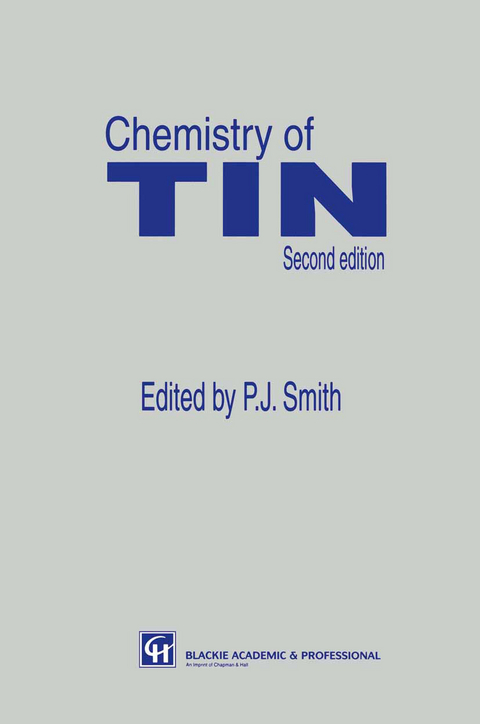
Chemistry of Tin
Chapman and Hall (Verlag)
978-0-7514-0385-5 (ISBN)
1 Tin-the element.- 1.1 From earliest times.- 1.2 Occurrence.- 1.3 Physical properties of metallic tin.- 1.4 Chemical reactions.- References.- 2 Compounds of tin: general trends.- 2.1 Electronegativity values, ionization potentials and elemental radii.- 2.2 Enthalpies of formation and bond energy data.- 2.3 Multiple bond formation.- 2.4 Structure and bonding in bivalent compounds.- 2.5 Structural behaviour of tetravalent tin compounds.- 2.6 Mixed-valence compounds.- 2.7 Compounds with metal-metal bonds.- 2.8 Theoretical studies of reaction pathways.- References.- 3 The inorganic chemistry of tin.- 3.1 Tin(II) chemistry.- 3.2 Tin(IV) chemistry.- 3.3 Mixed-valence tin compounds.- References.- 4 Formation and cleavage of the tin-carbon bond.- 4.1 Preparation of tin(IV)—carbon bonds.- 4.2 Cleavage of carbon-tin bonds.- References.- 5 Organometallic compounds of tetravalent tin.- 5.1 Introduction.- 5.2 Introducing reactivity: synthetic precursors to functionalized organotin(IV) compounds.- 5.3 Construction and reactivity of Sn-element bonds.- 5.4 Structural variations.- References.- 6 Organometallic compounds of bivalent tin.- 6.1 Introduction and review articles.- 6.2 ?-Bonded compounds.- 6.3 ?-Bonded complexes.- References.- 7 Tin-metal bonded compounds.- 7.1 Tin—alkali metal compounds.- 7.2 Tin—Group 2 metal compounds.- 7.3 Scandium, yttrium, lanthanides and actinides.- 7.4 Titanium, zirconium and hafnium.- 7.5 Vanadium, niobium and tantalum.- 7.6 Chromium, molybdenum and tungsten.- 7.7 Manganese, technetium and rhenium.- 7.8 Iron, ruthenium and osmium.- 7.9 Cobalt, rhodium and iridium.- 7.10 Nickel, palladium and platinum.- 7.11 Copper, silver and gold.- 7.12 Zinc, cadmium and mercury.- 7.13 Boron, aluminium, indium and thallium.- 7.14 Antimony and bismuth.- 7.15Silicon, germanium and lead.- 7.16 Tin—tin bonded compounds.- 7.17 Structure and bonding.- References.- 8 Radical chemistry of tin.- 8.1 Introduction.- 8.2 Organotin radicals.- 8.3 Homolytic reactions at the ligands in organotin compounds.- 8.4 Homolytic reactions at the tin centre.- 8.5 Organotin radical ions.- References.- 9 The uses of organotin compounds in organic synthesis.- 9.1 Applications of tin-hydrogen bonded compounds.- 9.2 Applications of tin—carbon bonded compounds.- 9.3 Applications oftin—heteroatom bonded compounds.- References.- 10 Recent studies on the mode of biological action of di- and trialkyltin compounds.- 10.1 Introduction.- 10.2 Neurotoxicity.- 10.3 Immunotoxicity.- 10.4 Cellular and biochemical aspects of the activity manifestation.- 10.5 Conclusion.- Abbreviations.- References.- 11 Health and safety aspects of tin chemicals.- 11.1 Introduction.- 11.2 Inorganic tin compounds.- 11.3 Organotin compounds.- 11.4 Manufacturers of tin chemicals.- Acknowledgements.- References.- 12 Industrial uses of tin chemicals.- 12.1 Introduction.- 12.2 The plastics industry.- 12.3 Glass and ceramics.- 12.4 Electroplating.- 12.5 Biocidal applications.- 12.6 Heterogeneous catalysts.- 12.7 Pharmaceuticals.- 12.8 Fire prevention.- 12.9 Miscellaneous uses.- References.- 13 Solid state NMR spectroscopy of tin compounds.- 13.1 Introduction.- 13.2 The early period (1978-1985).- 13.3 Compounds with four tin-carbon bonds.- 13.4 Organotin halides.- 13.5 Compounds with tin-oxygen bonds.- 13.6 Compounds with Sn-S, Sn-Se and Sn-Te bonds.- 13.7 Compounds with Sn-B and Sn-N bonds.- 13.8 Coordination complexes derived from R2SnCl2.- 13.9 Miscellaneous organotin compounds.- 13.10 Other measurements.- 13.11 13C measurements.- 13.12 Inorganic tin compounds.- References.- 14119mSn Mössbauer studies on tin compounds.- 14.1 Introduction.- 14.2 Hyperfine interactions and parameters.- 14.3 Instrumentation and experimental procedures.- 14.4 Treatment of spectral data.- 14.5 Isomer shift: fingerprint criteria.- 14.6 Nuclear quadrupole splitting: fingerprint criteria.- 14.7 Structure and bonding.- 14.8 Dynamics of Mössbauer nuclei.- 14.9 Applications to materials, and environmental interactions.- 14.10 Applications to tin industry.- References.- 15 The analysis of organotin compounds from the natural environment.- 15.1 Introduction.- 15.2 Analysis of inorganic tin compounds.- 15.3 Analysis of organotin compounds.- 15.4 Conclusion.- Abbreviations.- References.
| Zusatzinfo | XIV, 578 p. |
|---|---|
| Verlagsort | London |
| Sprache | englisch |
| Maße | 152 x 229 mm |
| Themenwelt | Naturwissenschaften ► Chemie ► Anorganische Chemie |
| ISBN-10 | 0-7514-0385-7 / 0751403857 |
| ISBN-13 | 978-0-7514-0385-5 / 9780751403855 |
| Zustand | Neuware |
| Haben Sie eine Frage zum Produkt? |
aus dem Bereich


